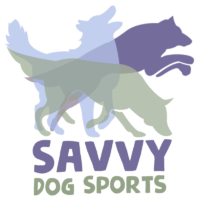In all aspects of life, our behavior is driven by consequences. When we do something that results in something negative – touching a hot plate – we will avoid doing that in the future. When a behavior results in something positive – a dog catching a mouse – that behavior is reinforced and likely to be repeated.
Using markers in training is the best way to capture behaviors we want. It’s a way to tell our dogs “YES, you did that correctly!”. We can add more clarity if we use different words to mean how they will be reinforced – a Location or Reward Specific Marker (LSM/RSM). Whether it’s with a toy or with food, we can tell them exactly what and how it will be delivered. Instead of just saying “yes”, we can use other markers to add more clarity for our dogs. “Take it” can mean getting a tossed toy. “Get it” for a tossed treat. Markers also simply tell our dogs that reinforcement is coming.
A really cool outcome of using LSMs is that if a dog truly prefers a toy, then they won’t be disappointed if we give them food and vise versa. They will know exactly what to expect when we communicate exactly how they will be rewarded. Dog’s crave consistency and predictability.
Location Specific Marker Examples for Nosework
I use 3 Specific Markers with my Nosework dogs
- “Yip”/”Alert” means “you found the hide”, stay there and I’ll bring the treat to you (also referred to as a ‘room service’ marker).
- “Break” means “you found the hide” and the dog can come to me to get the treat (also referred to as a ‘take out’ marker).
- “Finish” means we are all done and we will have a happy exit. “Finish” also means that reinforcement is coming in the form of rapid treats as we exit the search area.
To see the response our dogs give when they understand these markers is priceless and demonstrates the clear communication we can have with our canine partners.
Here’s an example of a ‘room service’ cue – my trial “Alert” marker. If I’m training on known hides, I say “yip”. If blind/trial, I say “Alert”.
Here is an example of my “Finish” cue. You can see her licking her lips in anticipating of our happy party exit with rapid treats!
Shouldn’t dogs always be rewarded at source?
I don’t believe dogs have to be rewarded at source when they have a strong foundation to stay at source until we communicate to them they will be rewarded. Most of the time I DO reward at source. My dogs have learned to stay with their feet still and near the hide when I say “yip”. And they know they can release from the hide and come to me when I saw “Break”.
“Break” used to be my release cue, but now it’s 100% a come to me for a food reward cue. It was a seamless transition as they already knew to release from what they were doing (a stay). “Break” is not the same as my “ok” cue that releases them from something and usually is not rewarded with food. It’s rewarded by what they get to do afterwards – for example going out the back door or to leave a hide to find more.
If I use my take out cue “Break” too often, I do start to see my dogs pull off the hide a bit more. Dogs are masters at anticipation and the odor/hide itself is an environmental maker that reinforcement is coming. To maintain your LSMs, you need to frequently test their understanding of each marker cue. You also need to vary your duration before marking to build that fight to hear their marker!
Recently I posted a maze with obstacles and a deep hide. This was the perfect hide location and setup to use my “break” take out Location Specific Marker. Moxie fights to get to source under the middle of the table. An “indication” around the edge of that table would be a “yes” in a trial – but I loved her determination to get as close to source as she could. She kept working until she heard the confirmation. If you notice – I wasn’t perfect. I accidentally said my room service cue first and then quickly cue’d “break”. I meant to just say “break”. We can always override one cue for another if we make a mistake or change our mind!
Should you use markers in Nosework?
Not everyone intentionally uses markers in nosework. No matter what we do there are always environmental markers or handler movement that tells the dog “YES, you did that correctly”. I like using verbal markers in Nosework since it creates a dog that is listening and not watching what we are doing. I want my dog to keep working or insist at the hide until they hear a marker.
The argument against using markers in nosework is that we can’t know exactly what odor is doing. We are simply communicating to our dogs that their Change of Behavior leads to reinforcement … that what we have taught them – to hunt and find source – will result in reinforcement. Our marker is a bridge to our delivery of reinforcement.
Want to train with me?
This term I’m teaching two courses and a workshop:
- NW120: Intro to Nosework Elements
- NW205: Creating Clarity with Contrasts.
- WW467: One of a Kind Hides (Workshop ends July 28th).
In all my courses I focus on clean training, mechanics and handling!
Course Recommendation
Want to learn more about marker cues? Shade Whitesel is teaching a course this term called FF145: Food Cues and Markers: Powerful Reinforcement for Clean Training. Learn from the expert!
I’ll be signing up and hope you do too!
Click here to register for Shade’s class
Thanks for reading!

Impressive